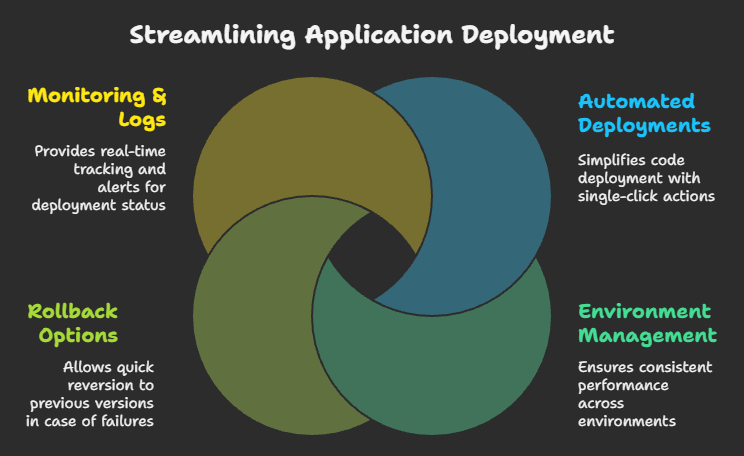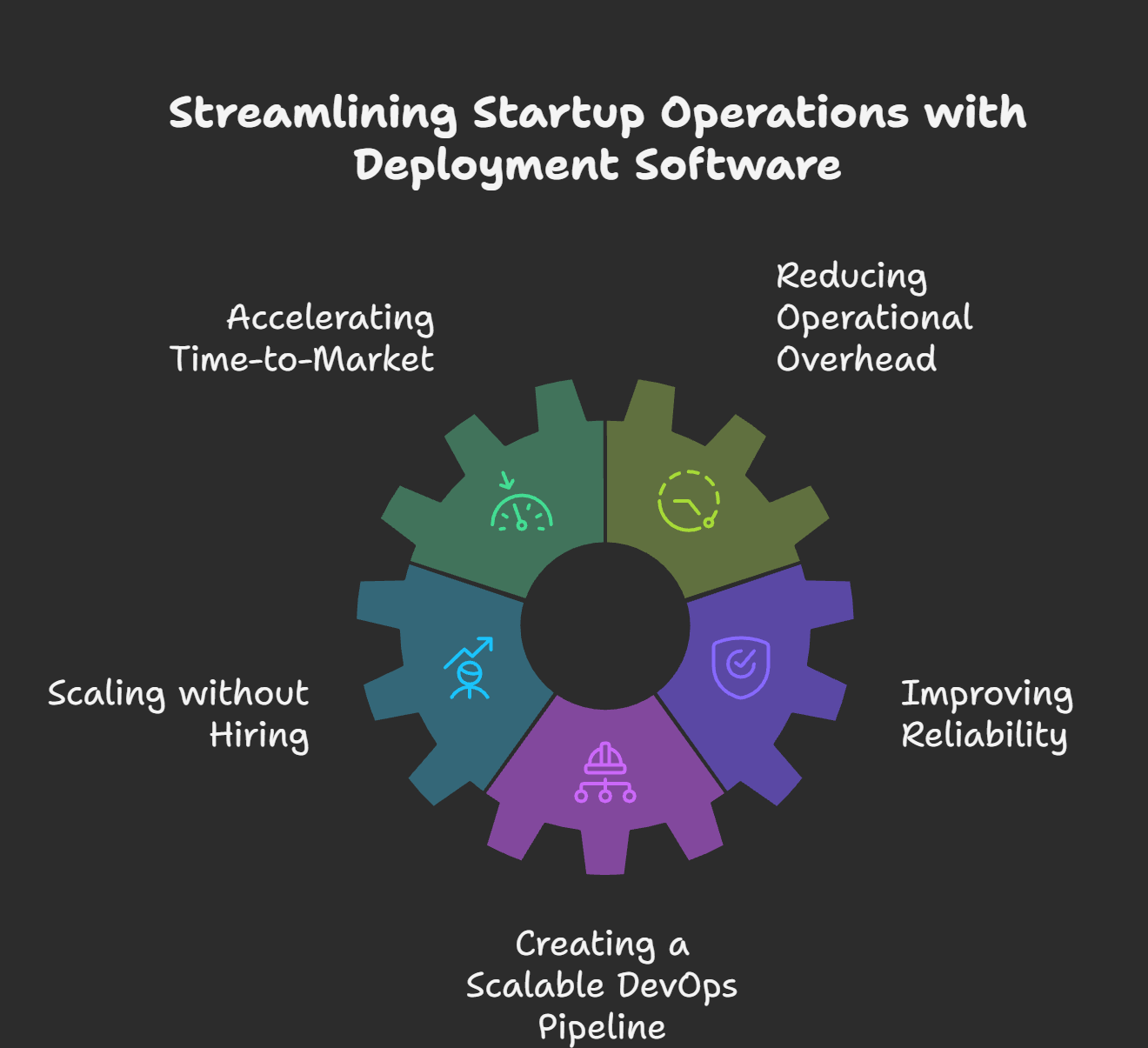Published
- 15 min read
Why Developers and Startups Need Application Deployment Software in 2025

Application deployment software can be a lifesaver, especially when the deployment process feels like a never-ending struggle.
For developers, the cost of managing deployments manually can be huge. Between complex scripts, inconsistent environments, and the constant risk of errors, it’s easy to feel like you’re spending more time fixing deployment issues than actually building your app.
For startups, the stakes are even higher.
You’re juggling multiple roles, often without a dedicated DevOps team. Each deployment failure not only costs time but also impacts your ability to ship features quickly, which can delay your business goals.
The complexity of deployment tools doesn’t help either.
Some tools are so feature-packed that they seem to require a degree in rocket science to set up. And if you’re working with a lean team, having to manage these complexities can quickly eat into your limited resources.
That’s where application deployment software designed for simplicity comes in. It helps you automate the whole process, removes the guesswork, and allows you to ship faster, so you can get back to what really matters: building great software.
Curious about the best tools to help you streamline this process? Check out our top software deployment tools for 2025
What Is Application Deployment Software Used For?

Application deployment software helps automate the process of taking your app from development to production. Think of it as the tool that gets your code live without the headaches, errors, or tedious manual tasks.
For developers, deploying manually is often time-consuming and error-prone. Whether it’s managing configurations, ensuring compatibility between environments, or trying to make sure your app doesn’t break when you push updates, it’s a lot to handle.
That’s where deployment software for developers comes in. It does the heavy lifting for you.
According to a study from Atlassian, teams that use automated deployment processes see a 25% faster release cycle and 50% fewer deployment failures compared to teams that don’t automate.
So, what exactly does application deployment software do?
- Automated Deployments: You no longer need to spend time manually pushing code or setting up servers. These tools can deploy your code with a single click or command, whether it’s automated application deployment or one-click deployment.
- Environment Management: With deployment software for startups and small teams, it’s crucial to make sure your code works the same way in every environment. The software automatically configures the environment settings so you don’t have to worry about “works on my machine” issues.
- Rollback Options: Things don’t always go as planned. If a deployment fails or introduces bugs, you can roll back to a previous version in seconds, minimising downtime and user impact. This is essential for keeping your app stable and trustworthy.
- Monitoring & Logs: Deployment platforms often come with real-time monitoring so you can track the success or failure of each deployment. If something goes wrong, you’ll be alerted immediately, making it easier to fix problems before they affect your users.
In short, deployment software allows you to focus more on writing code and less on managing infrastructure.
It’s a must-have for startups and developers who want to scale quickly without losing control over their product’s quality.
If you’re still exploring the best options for your team, check out our list of the best application deployment tools in 2025
Key Benefits of Application Deployment Software for Developers
When you’re a developer, your focus should be on coding and creating, not spending hours dealing with deployment headaches.
Here’s why application deployment software is a must for every development and deployment:
Speed and Efficiency: Automated Deployments
One of the most significant advantages of application deployment software is the speed it offers. With manual deployments, developers often spend hours managing configurations, pushing updates, and handling the logistics of the deployment process.
A State of DevOps Report by Google Cloud found that teams that automate their deployments are able to deploy up to 30 times more frequently, with 200 times faster lead times. This means new features and bug fixes reach production much faster, ultimately giving companies a competitive edge.
For developers who need to iterate quickly or startups aiming to launch features faster, having automated deployments is a huge time-saver.
Fewer Errors, More Confidence
When deployment is done manually, errors can creep in. Even small mistakes can cause significant issues. Whether it’s forgetting a configuration step, introducing a bug, or pushing the wrong version of the app, deployment software for developers significantly reduces human error.
In fact, companies that implement CI/CD automation report 50% fewer deployment failures than those that rely on manual deployments.
Rollback Made Easy
No deployment is perfect, and sometimes things don’t go as planned. With traditional deployment processes, a failed deployment could mean hours or even days of trying to fix things, which can lead to downtime, a costly situation for any business, especially startups.
According to GitLab’s 2021 DevOps Report, 85% of organisations that use automated deployment tools with rollback capabilities report faster recovery times after a failed deployment. This minimizes the risk of long periods of downtime, which can significantly affect both user experience and company revenue.
For startups aiming to scale quickly, being able to roll back deployments instantly can save valuable time and resources.
Time-Saving for Startups and Small Teams
For startups, time is everything. You need to launch new features fast, fix bugs quickly, and scale without overburdening your small team. Manual deployments or managing complex infrastructures can drain valuable time and resources.
By automating the deployment process, application deployment software frees up developers to focus on what they do best: building the product.
According to a report by Forbes, startups using automated deployment tools see a 35% increase in team productivity, leading to faster delivery times and better product iterations.
For a startup, every minute counts. By adopting deployment software early on, teams can reduce operational overhead, cut deployment errors, and deliver updates more efficiently. This leads to quicker go-to-market times, which is crucial for staying ahead of the competition in the fast-paced startup world.
Looking to explore tools that can make deployment seamless? Check out our guide to implement one-click deployment
Why Startups Need Application Deployment Software?

As a startup, you’re juggling multiple roles, wearing many hats, and always looking for ways to do more with less.
Application deployment software can be a critical enabler to streamline your operations, especially in the early days when resources are tight, and speed is everything.
Here’s why startups should seriously consider using application deployment tools:
Accelerating Time-to-Market
Startups face the constant pressure to launch new products and features quickly. Application deployment software gives you the ability to deploy code in minutes, not hours. This rapid deployment is key to staying competitive in fast-moving markets.
For instance, startups that adopt continuous deployment practices can ship new features and updates daily, ensuring they stay on top of customer feedback and market demand. The ability to roll out updates quickly can be the difference between winning or losing market share.
Reducing Operational Overhead
In the early days of a startup, every team member is critical.
But the more you grow, the more time is spent on non-core activities like managing deployments, configuring servers, and debugging errors. By using deployment software, you automate these tasks and free up your team to focus on what truly matters: product development.
A survey by TechCrunch found that early-stage startups that adopt automation tools for tasks like deployment, testing, and monitoring can save up to 40% of their team’s time. This time savings means developers can spend more time building and improving products rather than dealing with tedious manual deployments.
Scaling without Hiring a Huge Team
For most startups, scaling is a gradual process.
But scaling your operations (especially with infrastructure and DevOps) requires significant resources, which might not be available early on. Application deployment software helps you scale your app without requiring a massive DevOps team.
Automated deployment tools reduce the need for hiring specialised deployment engineers, which is an expensive and time-consuming process.
According to Harvard Business Review, 64% of startups that leverage automation tools can scale five times faster with fewer resources. This is crucial for startups that need to grow quickly without increasing headcount.
Improving Reliability and Reducing Downtime
If your application crashes or experiences downtime, it can result in frustrated users, lost revenue, and a damaged reputation. Application deployment software minimises downtime by automating the deployment process and enabling quick rollbacks in case of failure.
Startups that use deployment automation report a 43% reduction in system downtime, according to research by Gartner. With automated deployment tools, you can reduce the time spent fixing deployment issues and ensure your app is always up and running, an essential factor when you’re building your user base and brand.
Creating a Scalable DevOps Pipeline
Startups need agility and scalability, and that includes their development processes. As your startup grows, you need a scalable DevOps pipeline that can handle increased complexity without slowing down development.
With automated deployment software, you can set up a pipeline that automatically handles code integration, testing, and deployment. This allows for a smooth transition as your team grows and your product scales.
A report by Forrester found that startups using automated pipelines report a 48% improvement in deployment speed, allowing them to scale operations faster and more efficiently.
Ready to get started with deployment automation? Explore how AI is revolutionising application deployment
Where to Start If You’re New to Application Deployment Software?

If you’re a startup founder, solo developer, or part of a small team new to this space, the idea of setting up application deployment software might sound intimidating.
But the truth is, you don’t need to be an expert to get started.
Here’s how to ease into it and how Kuberns is helping teams deploy with less complexity, faster setup, and more flexibility.
You Don’t Need a DevOps Team to Use Kuberns
One of the biggest misconceptions is that setting up deployment automation requires advanced knowledge or a dedicated DevOps engineer.
In reality, Kuberns is built to be developer-friendly, with guided setups, Git-based workflows, and simple dashboard.
Kuberns lets you deploy apps in minutes using AI without having to write deployment scripts or manage cloud configurations manually. You push your code, and it takes care of the rest. Whether you’re building a Next.js frontend, a Node.js backend, or deploying containers, it abstracts the complexity for you.
Already on Another Platform? You Can Migrate Without Downtime
Maybe you’re already using Heroku, Render, or even managing things on EC2 manually.
The thought of migrating your deployments might seem like a risk, especially with live users. But with Kuberns, teams can move their existing workloads without any downtime.
You can import your existing repo, plug in your environment variables, and have your app up and running. Zero-downtime migrations and rollback support are built in, so you’re never stuck with your current setup.
Save on Cloud Costs as You Scale
Many startups start with popular platforms like Render or Vercel, or Heroku, which are great for prototyping but quickly become expensive at scale.
Kuberns is built to be cost-efficient, especially for growing apps.
By giving you more visibility into your infrastructure and smarter resource allocation, Kuberns helps teams reduce cloud bills by 30–50% compared to managed PaaS platforms, all without sacrificing speed or reliability.
If your AWS or GCP bill has been creeping up, it might be time to rethink how you’re deploying.
If you’re a solo developer or part of a small startup team, you don’t need to spend hours figuring out which DevOps tools for startups to piece together. You need one app deployment platform that has everything in one place and just works automatically.
Start small. Keep it simple. And focus on what actually matters: shipping your product.
It’s Time to Change Your Deployment Process
Many developers and startup teams stick with clunky deployment setups because “it’s what we’ve always used.”
But those manual scripts, server configs, and scattered tools come at a cost. Wasted time, unexpected errors, and late-night fixes.
Kuberns exists to eliminate all of that.
Whether you’re launching your first app or scaling an existing product, it might be time to pause and ask: 👉 Is our current deployment process helping us grow or holding us back?
If it’s the latter, the solution might be simpler than you think.
Start deploying in minutes without the stress, scripts, or surprise costs.

People Also Ask
1. What is application deployment software?
Application deployment software helps developers push code from development to production with fewer errors and manual steps. It automates build, environment setup, testing, and releases, making the deployment process faster and more reliable.
2. Do I need DevOps knowledge to use deployment tools?
No. Platforms like Kuberns are built for developers who don’t want to deal with complex infrastructure. You can deploy your app with just a GitHub repo, no DevOps expertise required.
3. How is automated deployment different from manual deployment?
Manual deployment involves custom scripts, manual server setup, and a higher risk of human error. Automated deployment handles these steps for you, ensuring consistency and saving time. It’s also easier to roll back if something breaks.
4. What are the best deployment tools for startups?
The best tools are those that combine simplicity, scalability, and affordability. Startups should look for platforms that offer automated CI/CD, one-click deploys, logs, environment management, and cloud cost control, all without needing a full DevOps team.
5. Can I migrate my app from another platform to Kuberns?
Yes. Kuberns supports easy migration from platforms like Heroku, DigitalOcean, or AWS. You can move your app without downtime and start deploying instantly using their simple Git integration.
6. Does Kuberns help reduce cloud costs?
Yes. Since Kuberns runs on optimised AWS infrastructure, many users see up to 40% savings on their monthly cloud costs, without changing their app code.
7. Is application deployment software suitable for solo developers?
Absolutely. It removes the need to manage infrastructure manually and lets solo developers deploy faster, with fewer risks and more confidence.
8. Is Kuberns better than using AWS or DigitalOcean directly?
If you’re a developer or startup looking for simplicity, then yes. Kuberns manages infrastructure, deployment, scaling, and monitoring for you, all on top of AWS. So you get the power of AWS without the setup hassle, plus lower costs and a smoother experience.
9. Can I deploy multiple environments, like staging and production?
Yes. Tools like Kuberns support multiple environments by default. You can set up staging, preview, and production environments to test and manage your app with confidence.
10. How long does it take to deploy an app with Kuberns?
Usually under 5 minutes. Just connect your GitHub repo, select the branch, and click Deploy. No infrastructure setup or configuration required.
11. Does Kuberns support CI/CD?
Yes. Kuberns includes built-in CI/CD workflows. Your code is automatically built, tested, and deployed every time you push changes; no need to integrate separate CI/CD tools.
12. What kind of apps can I deploy on Kuberns?
You can deploy web apps, APIs, static sites, and more, built with frameworks like Node.js, Python, Django, Flask, Go, Next.js, and others. If your code runs in a container, Kuberns can handle it.